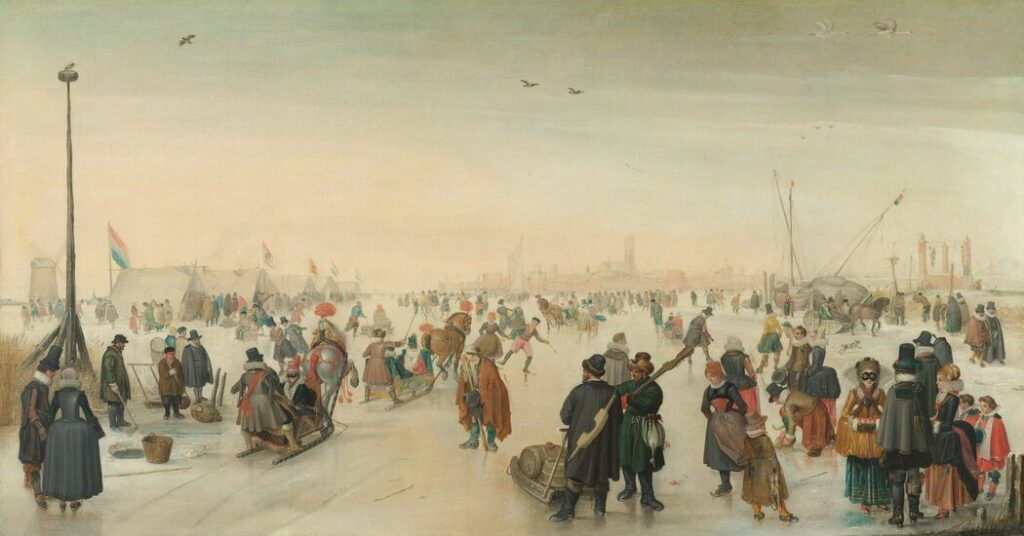Long before I knew his name, I knew Hendrick Avercamp’s paintings. They show a merry Christmassy world of funnily dressed people disporting themselves on frozen canals: paintings I knew from jigsaw puzzles and holiday cards. Here was a young couple gliding over the ice, love in their eyes; there were people exercising picturesque professions — a skate sharpener, a bird catcher, a chestnut seller.
But if you kept looking, you found a good-natured scabrousness. Behind that spidery tree was a man defecating, and over there was a woman who’d slipped and exposed her red buttocks, and there, beside the village inn, was a drunken fool being fished out of the ice. No other artist ever captured winter fun as well.
These scenes were so iconic, so Dutch, that I felt a bit bereaved, when I moved to the Netherlands more than 20 years ago, to realize that the world they showed was gone — and that thanks to climate change, it wouldn’t be coming back. Even the Elfstedentocht, the skating race through the 11 historic cities of Friesland that is one of the country’s most beloved national traditions and has been held 15 times since 1909, was passing from memory. The ice has to reach a certain thickness for it to be safely held, and the ice no longer reaches that thickness. What I found, in place of the sparkling white winters of the old paintings, was month after month of tepid drizzle.
It’s hard to overstate how excited the Dutch still get about the Elfstedentocht. Spirits rise as the mercury sinks. There are daily meteorological reports from little towns that are rarely mentioned in any other context. The race has its own vocabulary, in the Frisian language that the non-Frisian Dutch find adorable: “It giet oan” means the race is on — or, if the ice isn’t thick enough, “It giet net oan.” Since I moved to this country, only the latter has been heard. A whole generation has grown up since the last race, in 1997, though it almost happened in 2012. Every year, when it gets cold, the possibility of the race comes roaring through our screens.
What nobody can bring themselves to say is that the Elfstedentocht is gone.
Over.
Foarby.
Living in a country protected from the sea by huge manufactured barriers, we are starting to understand that even these heroic constructions will not be strong enough for climate change. I’ve often imagined the collapse of dune and dike and the cultural losses such a cataclysm would bring. If the western Netherlands — all those cities, at or even below sea level, with all those museums and libraries — were swept into the sea, which treasures would we miss most? (I’d stuff the Frans Hals group portraits, in his museum in Haarlem, into my little lifeboat.)
And when we imagine the losses to cultural heritage that global warming entails, we often think of things we’d try to rescue or buildings we can’t move or a few striking images: snowless Alps, drowned Venice. We don’t always think about the immaterial losses that warming will bring — or, in the case of the Elfstedentocht, that it already has. When the freak hurricane, the unexpected drought or the unbearable heat wave passes, we get on with our lives, unable to admit that some things are not coming back.
Thank you for your patience while we verify access. If you are in Reader mode please exit and log into your Times account, or subscribe for all of The Times.
Thank you for your patience while we verify access.
Already a subscriber? Log in.
Want all of The Times? Subscribe.
Source link : https://www.nytimes.com/2024/01/03/opinion/snow-deficient-europe.html
Author :
Publish date : 2024-01-03 08:00:00
Copyright for syndicated content belongs to the linked Source.
